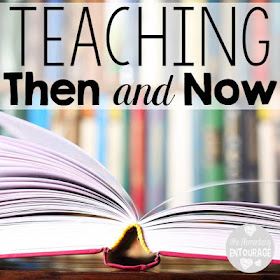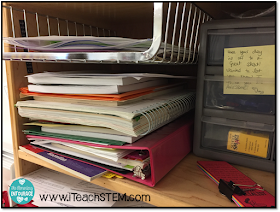Times have changed. Even in the eleven years I've been teaching, I've noticed BIG differences in how I plan and teach my lessons. Despite teaching fifth grade all eleven years, I have found that the way I deliver instruction and the way I check for understanding have not only changed but improved!
As I sat down to type this, I started to think back to when I was in high school. I always loved science. It was the class where I was able to talk to my friends, work in groups, and do experiments. I did well in those classes and when I had the opportunity I would sign up for extra science classes. So why was science more interesting? Because I was actually a PART of the learning process. I was engaged in what I was learning. I was applying the content during experiments. I was communicating with my peers.
When I first started teaching, my lessons came directly from the adopted textbook. I taught each lesson in order. I assessed using the provided tests. My lesson planning was super easy, though. I just wrote down the page numbers in the teacher's manual and moved on. But to tell you the truth, I usually spent my lunch and planning times stressed because I was trying to re-read and understand what on earth I was trying to get my students to do that day. Let's be honest. I was in survival mode - trying to teach all subjects
every day to a group of fifth grade students who were almost as tall as
me!
The problems was, students were rarely excited about my lessons. They listened, mostly. They practiced what I asked. They did homework. And they performed decently on tests. But they were B-O-R-E-D. And so was I! Let's be honest, reading a chapter and answering questions get old pretty quickly. For both students AND their teachers.
My teacher manual sits on a shelf behind my teaching station (nope, I don't even have a desk anymore). I think the last time I grabbed it was to show students a diagram in the book so they wouldn't have to dig for their own textbooks (that they rarely use). I plan each lesson using various resources. I include multiple learning styles and hands-on strategies. I spend time looking for ideas on Pinterest, TeachersPayTeachers, and Google that will enhance the lessons I already have developed. I have been able to take ownership of each lesson that I teach. Which means I am NOT spending my lunch stressing, but EATING (novel idea, I know).
But change wasn't easy. Letting go of a provided curriculum took a leap
of faith and (gasp) a lot of work on my end. I needed to be sure that
what I was teaching the students helped them to be prepared for those
end of the year tests we all love (dripping with sarcasm). But, here's
the thing. When students make connections to the content they are more
likely to
remember what they have learned and be able to apply their knowledge in
various situations. It's a win-win situation.
Here are some tips for moving away from the teacher manual and moving toward more engaging lessons that will not only capture your students' attention but allow you to cater to their learning styles and personal interests.
My first year of teaching I was the ONLY fifth grade teacher at a very small school. While I did my best to ask for help and work with other teachers, I was basically on my own. Not only was it lonely, but it was hard. I didn't really have anyone to bounce ideas off of or ask for input. I'm lucky that now I work with a great team of teachers. However, I am still the ONLY fifth grade STEM teacher. So I've had to get creative with how I collaborate. I have joined several Facebook groups where we can share ideas and resources. I also get together with other STEM teachers in my district on occasion to plan and develop activities.
Let's be honest, some of the PD classes are downright boring. We are just like our kids. If we can't see a direct connection between the content and our lives, we disengage. So choose your professional development activities wisely. Is there a new piece of technology you'd really like to integrate? Look for a class that focuses on that. Do you need a chance to meet with other teachers to develop lessons? See if your administrator will let you spend a half day collaboratively planning. Would watching another teacher help you improve your own lesson delivery? Find someone willing to let you observe them once or twice. Have you come across a great teacher's blog who has ideas that you'd like to incorporate into your own classroom? Read what has been written. Comment or even email the teacher with questions. You'll be surprised at how much you can learn from someone you've never even met in person!
And don't be afraid to share your OWN expertise. I just took a leap out of my comfort zone and led a session on interactive notebooks last summer. Not only was it a great opportunity to share my ideas, but it was amazing how many other approaches were shared that I have begun to integrate into my own classroom.
Good teachers do this automatically. We think about what went well and what didn't work as well as we had hoped. The key is to make changes based on your reflections. Since I'm the only science teacher in my grade level, I often share how things went with my husband. (Poor guy.) I tell him about the day and what I wish I had done differently. Sometimes just saying it out loud - even to a non-teacher like my husband - helps me to come up with ways to improve the activity.
The planning process has actually gotten much quicker for me over the years. Mostly because I take the time to reflect on my lessons and write notes to myself. I keep a journal for each of my classes, and save one from each year to use as a resource the following year.
When I am reflecting on each activity or unit, I jot notes to myself on Post-its and stick them right in the journal. That way when I open up to the pages, I am reminded of what I wanted to change and how I could improve the lesson. It's almost like a teaching diary!
Don't get me wrong. This is not easy. In eleven years of teaching, I still get bogged down and want to give up - at least once a week if not more. But then I remind myself that my students are learning and that the process is just as important as the end result. I also spend a lot of time in my teaching partner's room venting and bouncing ideas off of her. She's great for that!










No comments:
Post a Comment